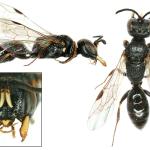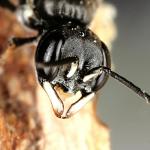Devon to Kent, Wales and north to mid-west Yorkshire and Morecombe Bay.
A widely distributed central and southern European species, also found eastwards through Asia to Japan (Lomholdt 1975-76). The species may be Holarctic, as Vincent (in Bohart & Menke 1976), synonymised the nearactic P. ithacae Krombein, 1938, with P. insignis. Thus enlarged, P. insignis is also found in Canada (Alberta) and the north-east United States to Virginia. (It is also possible that the taxon 'P.ithacae' includes both P. insignis and P. monilicornis).
This species is not regarded as being scarce or threatened. Richards (1980) commented that it is not common.
Found in a variety of open, ruderal habitats.
Late May to mid-September, but most frequently June to July.
The prey is Homoptera of the families Aphididae and Lachnidae (Lomholdt 1975-75).
The nests are constructed in abandoned beetle burrows in decayed wood or in stems with the pith excavated. P. insignis is reported to supersede other species of Sphecidae in nest burrows and, possibly, compete for such nests (Lomholdt 1975-76). In a stem nest there may be as many as 15-18 cells. The larva has been described by Janvier (1961), and a female and an occupied nest are illustrated by Blösch (2000). Krombein (1967) described in detail the nest structure of 'P. ithacae' in wooden trap nests.
No information available.
A captured female P. insignis was found to be bearing several specimens of an unidentified (?) acarid mite (G W Allen, pers. obs.). It is assumed that these were reared in the nest. In North America, Fye (cited by Krombein 1967) reported the ichneumonid wasps Poemenia albipes and P. sp. near americana, and the chrysidid wasps Omalus aeneus and O. sp. near iridescens, as parasitoids/clepotparasites of 'P. ithacae'.
2002



